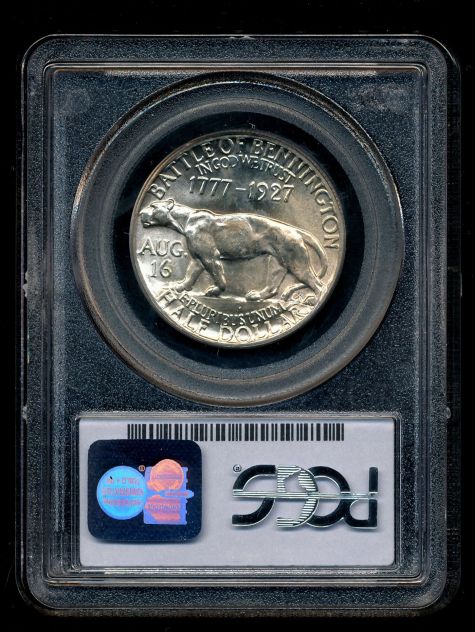The US Government participated in commemorating the 150th anniversary of the Battle of Bennington and Vermont's Independence in several ways. Most-known examples to collectors are the 1927 Battle of Bennington / Vermont Independence Sesquicentennial Half Dollar and the Two-Cents postage stamp celebrating the same.
1927 Battle of Bennington / Vermont Independence Sesquicentennial Half Dollar
 1927 Battle of Bennington / Vermont Independence Sesquicentennial Two-Cent Postage Stamp
1927 Battle of Bennington / Vermont Independence Sesquicentennial Two-Cent Postage Stamp (Image Credit: National Postal Museum, Smithsonian Institution. Fair use, education.)
(Image Credit: National Postal Museum, Smithsonian Institution. Fair use, education.)Additionally, a US Vermont Sesquicentennial Commission ("Commission") was established by Congress and approved by US President Calvin Coolidge. The Commission was comprised of nine members (three Senators, three Representatives and three appointees of the President) - with Coolidge as its honorary Chairman - and was to be a participant in the Sesquicentennial's commemoration, but wasn't to plan, develop or coordinate it - such responsibilities were left to the State Commission.
A Joint Resolution was introduced in the House of Representatives for the Commission in April 1926, during the 69th Congress, by Elbert Sydney Brigham (R-VT). In its original form, the Resolution included an appropriation of $4,000 for travel and subsistence expenses of Commission members while away from Washington, DC carrying out their Commission responsibilities. It also included an additional $5,000 appropriation to be used at "the discretion of the commission for the appropriate participation on the part of the United States in the celebration and observance of the one hundred and fiftieth anniversaries of the independence of Vermont and the Battle of Bennington, to be commemorated in 1927."
The Resolution was referred to the Committee on Industrial Arts and Expositions. The Committee held a Hearing on the matter and subsequently returned a favorable report with a recommendation for the Resolution to be passed. When it was brought up for consideration in the House, George Austin Welsh (R-PA) offered an amendment to the Resolution that reduced the travel allowance to just $1,000 and completely removed the $5,000 appropriation for other tangible participation by the Commission/US.
The Resolution, in its greatly reduced, amended form, was passed by the House. It was subsequently passed by the Senate and approved by US President Calvin Coolidge. With such a small appropriation, it seems clear that little importance was placed on the participation by the Federal Government in the Bennington-Vermont Sesquicentennial commemoration - the minimal-scope Commission was the least Congress could do to recognize a battle victory that helped turn the tide of the American Revolution in favor of the Americans. If not for the commemorative half dollar and postage stamp, the Federal Government would have quite nearly ignored the historic event!
In the end, the US Commission had only minor involvement with the Bennington-Vermont commemoration, with just a few Commission members traveling to Vermont to participate in the event's parade - none of its members were featured speakers. (A letter sent by President Coolidge, a Vermont native, was read at the program, however - it was well received.)
Per the
Combined Statement of Receipts, Expenditures, and Balances of the United States Government - 1928, of the $1,000 appropriation, just $137.36 was used, leaving a balance of $862.64. So, the $1,000 travel appropriation proved adequate, but, IMO, was a bit of a self-fulfilling prophecy.
For other of my posts about commemorative coins and medals, including more on the Bennington / Vermont half dollar, see:
Commems Collection.























